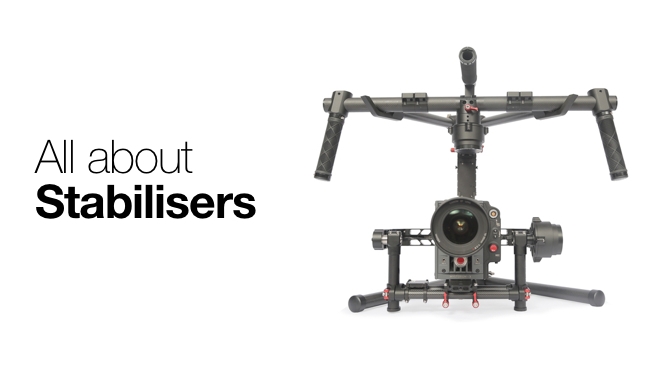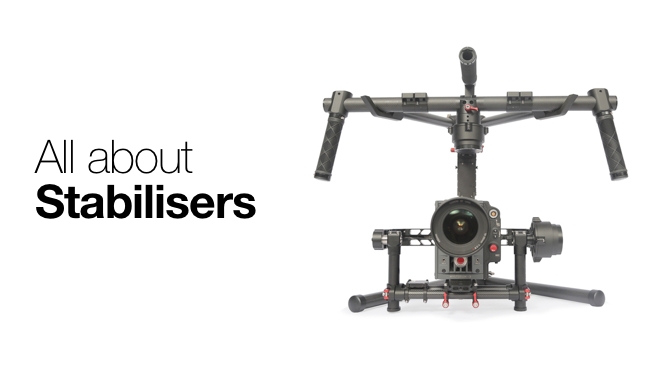
 All about stabilisers
All about stabilisers
Shooter and predator (producer/editor) Simon Wyndham provides us with his primer on camera stabilisation.
With all the talk of new camera technology, it is all too easy to forget that many other aspects make up a great image.
Camera movement has always been high on a cinematographer's list of ways to make a shot more dynamic and interesting. Used cleverly, camera movement can speak for the emotion of the story. Used badly and it can draw unwelcome attention to itself.
There are many ways to obtain movement, but the holy grail has always been to free the camera from as much restriction as possible. With new technology, such as brushless motors and easily accessible open source control circuitry, free camera movement is becoming available to more people than ever before.
The Steadicam
When Garrett Brown invented the Steadicam after many years of experimentation, it was a revelation. So good was his device, and of course his operating skill, that even the rather crude prototype that he used for the very first ever Steadicam shot in a feature film produced a result that even now is considered incredibly technically proficient.
Brown is very protective of his invention, and rightly so. While the original patents have now run out, allowing rivals to produce variations on the 3A arm based rig, Garrett continues to innovate.
There are a number of drawbacks to the Steadicam and similar devices, however. First and foremost is that using a Steadicam requires a huge amount of skill. To be considered technically proficient at using one, the shot must be so stable as to never draw attention to itself or be 'floaty'. Using a Steadicam at slow speeds is an almost a Jedi like skill!
In fact, if you have never used a rig before, expect to spend a full year of daily practice in order to obtain even the simplest of shots with any degree of proficiency. In short, you cannot just purchase a Steadicam and expect to use it on a production straightaway. The monetary investment can be massive, and so is the investment in practice time and skill development.
No matter how expensive the rig, nothing will compensate for a lack of skill when it comes to Steadicam. Because of this fact, if you are an experienced operator with a good reputation, you can expect to be able to make a living out of operating a Steadicam alone, but where does that leave the rest of us?
Smaller rigs
Tiffen, the owners of the Steadicam brand, now produce a number of options for those on a budget. Smaller and lighter Steadicams, such as the Pilot, are every bit as technically capable as their larger brethren. They also require the same skills to operate. In some ways, they require even better skills to use well because they don’t have the benefit of inertia like the larger sized rigs.
Other options such as the Merlin hand held device also allow very light cameras to obtain smooth movement. However, this still requires high skill levels and extremely tactile and sensitive control in order to obtain truly good results.
Technology to the rescue
A couple of years ago, the world of camera stabilisation was turned upside down. When Vincent Laforet posted up a demo of what he had achieved with a new device called the Movi, the internet geeks went wild.
The Movi changed the world of camera stabilisation. Here was a device that allowed users with no Steadicam skills to be able to obtain rock solid, free camera movement with comparatively minimal practice.
Instead of relying purely on physics, the Movi utilises lightweight brushless motors and a control board to automatically compensate for any movement on three separate axis. In a fantastic show of how democratic things have become, now anybody can obtain open source control boards for such devices and build their own, such is the accessibility of the technology.
There are now a high number competing devices available, both as Kickstarter projects, and as commercial products, including the new Dji Ronin, which is set to change things again with its very reasonable pricing and ease of setup.
Is this the end of the Steadicam?
When the Movi exploded onto the scene, it understandably worried a few Steadicam operators. Could such devices really spell the end of the Steadicam?
Certainly brushless gimbal stabilisers can take on a lot of the duties of a Steadicam, and will be of particular use to smaller companies who have neither the skills nor the money to hire a Steadicam operator.
They also allow for easier, more compact transportation, meaning that Steadicam style shots can now be obtained in the type of remote or hard to access places that would be a logistical nightmare to achieve with a Steadicam rig.
Brushless stabilisers also allow for takes that are nigh on impossible with Steadicam, such as being able to pass the device to another operator off a balcony, or to hand it over through a small window or hole in a wall for some seemingly impossible looking shots. Such devices can also be used in confined spaces where a Steadicam is just too impractical to consider.
On paper it seems that the Steadicam has had its day. Or has it? Steadicams still have a lot to offer. For one thing, a Steadicam operator is fully able to pan and tilt the shot. With a brushless gimbal stabiliser, such fine control over framing often has to be done with a second operator with a radio control device. This is something that needs total coordination between the gimbal operator and the camera controller and could well be as high a skill to do well as operating a Steadicam. Add in the need for remote focus and a brushless gimbal stabiliser could require up to three people to operate effectively for complex shots.
A Steadicam supports the weight of the camera rig through the body and legs of the operator. While a heavy Steadicam is tiring to operate, it is the operator's whole body that is taking that weight. On the other hand, a brushless gimbal stabiliser puts all the weight through the operators arms and wrists.
This is not an insurmountable problem, though, as it should be fairly easy for somebody to come up with a body support rig.
In many ways, the two device types could support and compliment each other. Some have suggested the idea of mounting a brushless gimbal on a Steadicam so as to obtain the types of shots that were only previously possible on the rather unwieldy, yet innovative 'Alien Revolution' rigs, which allows floor-to-jib height shots from a Steadicam.
The wonderful thing about all these developments is that it means that more versatile camera movement is becoming available to us all, and for ever more affordable prices.
One more thing
Cinevate, a Canadian manufacturer of camera sliders and support rigs, is close to releasing their rather nifty looking Morpheus rig. While it is designed for cameras like the GoPro or Blackmagic Pocket Cinema Camera, the Morpheus is an innovative take on the handheld stabiliser, combining a Steadicam style device with a ready to go slider, and even handheld jib abilities. There is even a progressive, integrated, magnetically-operated panning device in the handle. We hope to be taking a close look at it as soon as it becomes available!
Tags: Production


Comments